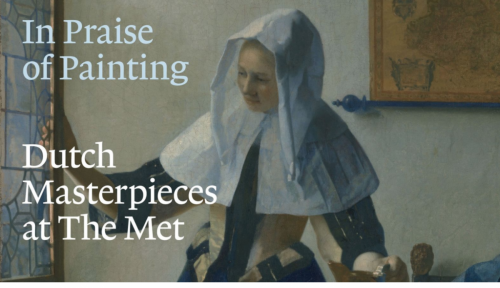Reading the Dutch Masters at the Met by Heidi K. Weber
What seems like a lifetime ago, before our pandemic world erupted, The Metropolitan Museum of Art opened In Praise of Painting: Dutch Masterpieces at The Met to rave reviews. Peter Schjeldahl wrote in The New Yorker: “This installation rings the lower level of the Lehman Wing with scores of lesser-known gems from the mid-seventeenth century, many of them rarely on view before, amid masterworks by Rembrandt, Vermeer, Hals, and Ruisdael.” Thankfully, the exhibit is ongoing.
Crafted as The Met undertook its skylight renovation of the European galleries, the exhibit honors the artists, curators, and benefactors who contributed to The Met’s 150-year history of collecting art from the Dutch Golden Age. Curated by Adam Eaker, Assistant Curator of European Painting, the exhibition inspires a new conversation about some of The Met’s most celebrated works.
If you have not seen the exhibit, I encourage you to take a look. It is compact and manageable. If you’ve already visited, you might consider reading one of the books recommended here—all available at the New York Society Library—then return to The Met for a second viewing, or peruse the exhibit on The Met’s website.
Before I get to pairing specific paintings with books, I will begin with recommendations that provide a more general overview of 17th-century Dutch culture, a history of the Thirty Years War (1618-1648), and the Dutch Masters in relation to novelists Balzac, Eliot, Hardy, and Proust. Given the number of books one could propose, this is a mere sliver of offerings.
17th-Century Dutch Culture 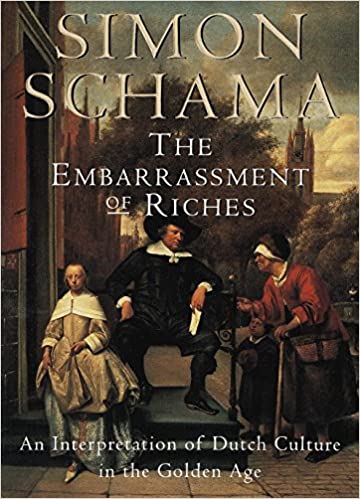
A few decades ago, the British historian, media star, and Columbia University professor Sir Simon Schama brought the Dutch Golden Age to our attention with his expansive and unique cultural exploration, The Embarrassment of Riches: An Interpretation of Dutch Culture in the Golden Age (1987). This is not a book about the art, architecture, or literature from the Dutch Golden Age, although Schama touches on each of these arenas. Rather, it is a book that probes beneath the surface to expose the Dutch temperament, their social beliefs, and behaviors. As Schama tells us, his book is about the small c’s in culture.
Like fine Dutch lace, Schama interweaves tales of seemingly hodgepodge behaviors from Dutch culture to paint a complicated panoramic picture of a people whose lives were often torn between Calvinist sentiments of simplicity and the desire for exotic global goods.
For example, the Dutch were obsessed with cleanliness. Schama argues it was a moral imperative to forestall "foreign invaders" from polluting the Dutch well-being. All the while, the Dutch were busy outfitting their ships and opening their ports to imports of exotic consumer goods coveted by the growing merchant class. The paintings in this exhibit reflect this expanding world view. Chinese porcelain appears in still life paintings, and large maps adorn the walls of interior spaces.
In recent years, Schama has come under fire for barely mentioning the active Dutch participation in the slave trade and the often brutal colonization of the Americas, Indonesia, and Africa. If a third reprint is ever released, one hopes textual additions will be made.
(More books on 17th-century Dutch culture in the Library’s collection may be found here.)
Conflict and War
Two significant conflicts erupted on the European continent during this period.
The Eighty Years' War, perhaps better defined as the Dutch War for Independence (1568–1648), was an on-again/off-again revolt by the seventeen Provinces against Spanish rule. This conflict is frequently referenced in the exhibit’s supporting documentation.
A more extensive geographic conflict involving most of the European continent was the Thirty Years' War (1618-1648). The Britannica Online succinctly recaps the thirty years as “a series of wars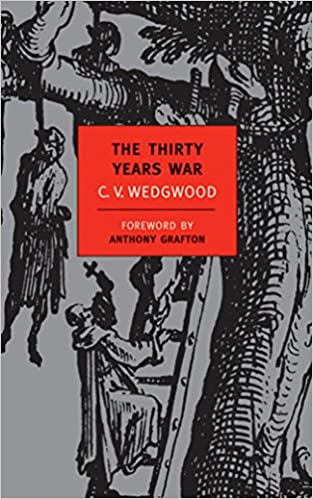 fought by various nations for various reasons, including religious, dynastic, territorial, and commercial rivalries. Its destructive campaigns and battles occurred over most of Europe, and, when it ended with the Treaty of Westphalia in1648, the map of Europe had been irrevocably changed.”
fought by various nations for various reasons, including religious, dynastic, territorial, and commercial rivalries. Its destructive campaigns and battles occurred over most of Europe, and, when it ended with the Treaty of Westphalia in1648, the map of Europe had been irrevocably changed.”
If Schama is Rembrandtesque with an unreserved ego, C.V. Wedgwood is a quieter, more Vermeer-like personality who brought the folly and tragedies of these conflicts to life in her 1938 classic The Thirty Years War. Still in print with New York Review Books Classics, Wedgwood’s scholarship and style paint a vivid picture of the miseries of ordinary men in the mercenary armies, and the squalor of peasants robbed of their crops, animals, and virtues. Wedgwood profiles the myriad self-obsessed personalities in “leadership" roles whose decisions and actions wreaked havoc for no good purpose except to satisfy their own egos. The story will resonate in today’s world.
In the introduction that Wedgwood provided for the 1956 edition, she wrote:
“Many of my generation who grew up under the shadow of the First World War had a sincere, if mistaken, conviction that all wars were unnecessary and useless. I no longer think that all wars are unnecessary; but some are, and I still think that the Thirty Years War was one of these. It need not have happened and it settled nothing worth settling…The dismal course of the conflict dragging on from one decade to the next and from one deadlock to the next, seems to me an object lesson on the dangers and disasters which can arise when men of narrow hearts and little minds are in high places.”
C.V. Wedgwood (pen name of Dame Cicely Veronica Wedgwood (1910–1997), a direct descendant of the famous Wedgwood china dynasty) charted a unique path in scholarship and her personal life (her partner of 70 years was Jacqueline Hope-Wallace) through two world wars and massive cultural change. Reading Wedgwood’s history serves to remind us again that great art is often created on canvas—and on the page—as unfettered upheavals unfold in the streets.
Dutch Masters and the Realist Novel 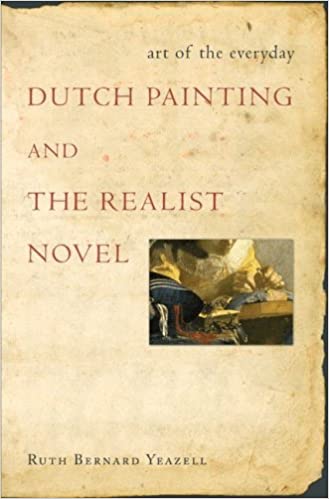
Ruth Bernard Yeazell, Sterling Professor of English at Yale University, brings paint and print together in Art of the Everyday: Dutch Painting and the Realist Novel (2008). It is a recommendation by The Met’s exhibit curator Adam Eaker, who describes it as a fascinating exploration of “cross-media artistic inspiration across centuries.”
After a brief survey of Dutch painting, Yeazell focuses on the impact of Dutch painting on the 19th-century realist novels of Honoré de Balzac, George Eliot, Thomas Hardy, and Marcel Proust. Each was touched by Dutch painting. In the opening lines of her preface, Yeazell lays out her enterprise:
“How is a novel written in nineteenth-century Britain or France like a picture painted in seventeenth-century Holland? To pose this question is not to engage in a modern parlor game but to address a problem in the history of taste: what did the art of the Dutch Golden Age mean to the nineteenth century, and what was at stake when critics invoked its precedent—as they often did—to justify or attack the realistic fiction of their day? Why should the novelists themselves have been drawn to seventeenth-century Dutch art, and why, nonetheless, did “dutch painting” in fiction remain a source of deep ambivalence even for those who most obviously looked to such painting for a model?“
If this introduction speaks to you, this work of literary criticism will get you to see the realist novel with fresh eyes.
PAINTINGS AND BOOKS
Curator Adam Eaker said as the exhibition opened, “disparate works, including some usually consigned to storage, are arranged thematically in an attempt to tell a new story.” With this presentation of paintings that otherwise do not normally hang together, often because of benefactor restrictions, The Met framed a visual conversation about the complex identity we as humans create out of our religion, history, gender, occupations, and social entertainments.
That conversation expands when we match several paintings from the exhibit with books from the New York Society Library’s own unique collection.
EXHIBIT PAINTING 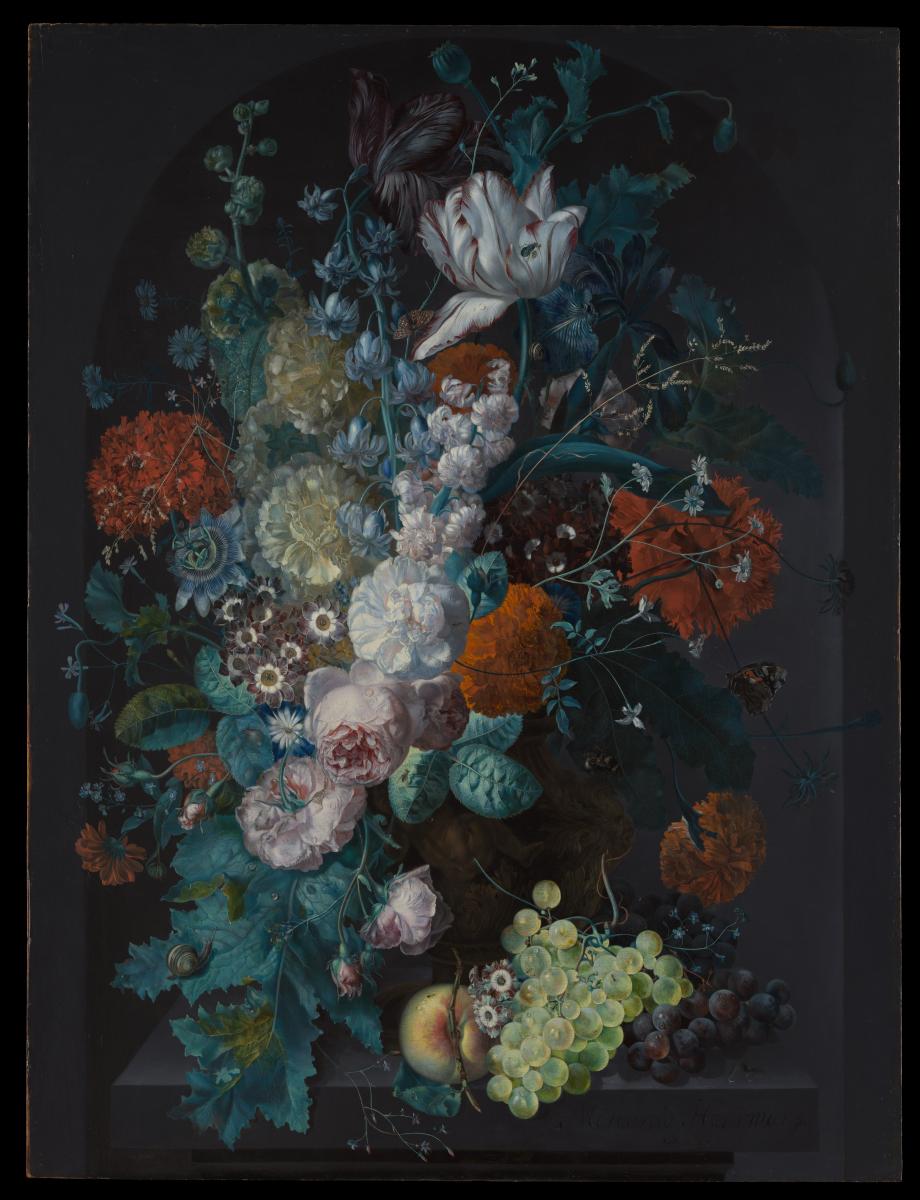
A Vase of Flowers (1716) | Margareta Haverman
This explosion of flowers was acquired by The Met in 1871 for about 3,000 francs (or about $500 at the time) and long held in storage. Though it is dated slightly past the generally accepted period for the Dutch Golden Age, Adam Eaker decided to include Margareta Haverman’s opulent and splendid flower arrangement in this exhibit.
Haverman is one of the few female artists found on record from that period. Only two signed Havermans are known today. There’s some irony in this scarcity, given the availability of her flower images on pillows, mugs, carry bags, drink coasters, datebooks, sleeveless tops, and iPad covers.
Unlike the bold and beautiful flowers that reach beyond her canvas to touch us, there’s little that reaches out to us about Haverman. The record shows she was born in 1693 and died sometime after 1739. She was apprenticed to a popular flower painter Jan van Huysum at the urging of her father, a schoolmaster, and married the architect Jacques de Mondoteguy. They moved to Paris in 1721, where she was elected to the Académie Royale de Peinture et de Sculpture, from which she was later expelled. Mystery surrounds this episode, and much of her life is clouded in controversy.
NYSL Book Recommendation
The Last Painting of Sara de Vos | Dominic Smith (2016) 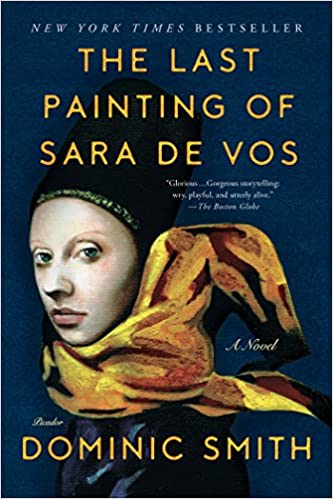
Mystery is also the byword for Dominic Smith’s historical fiction The Last Painting of Sara de Vos. This bestselling novel intertwines the stories of three characters living on three continents in three different eras: Amsterdam, 1631; New York City, 1957; Sydney, 2000.
The book begins with Sara de Vos, a fictional Dutch painter of the Golden Age whose talent is great enough to get her admitted to the prestigious Guild of St. Luke. The Guild was the ‘union’ of painters and artisans that regulated their practices and trade. Few women were admitted to the Guild, and they were restricted in the subject matter they were allowed to paint. The author, while living in Amsterdam, got interested in the handful of female painters who were admitted to the Guild, especially the painter Judith Leyster. Thus the starting point for this novel. Smith’s novel is also about the intriguing world of art forgery, museum operations, and rich donor desires. It’s an entertaining read to accompany The Met’s exhibit.
EXHIBIT PAINTINGS
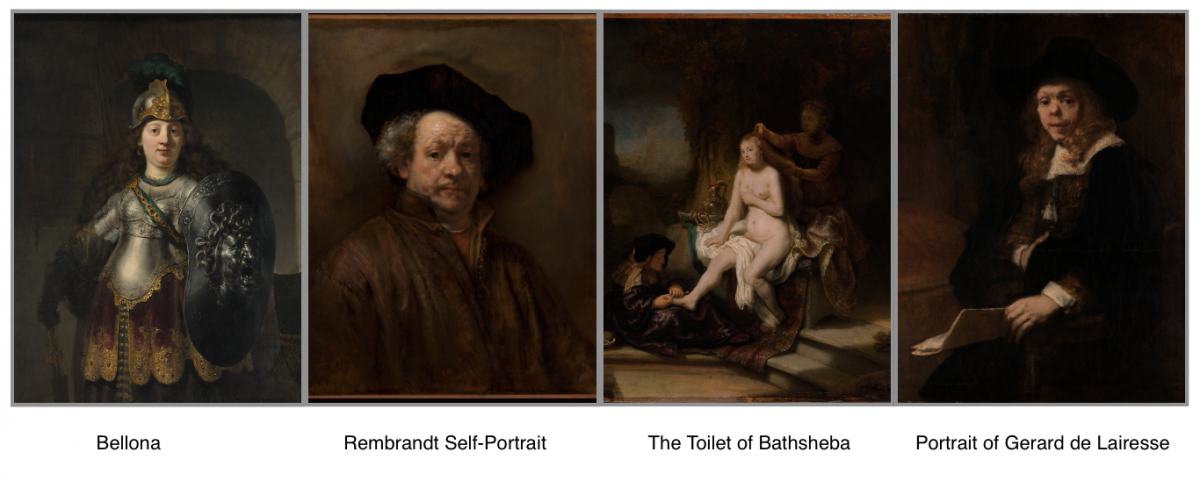 Bellona (1633) | Rembrandt
Bellona (1633) | Rembrandt
Rembrandt Self-Portrait (1660) | Rembrandt
The Toilet of Bathsheba (1643) | Rembrandt
Portrait of Gerard de Lairesse (1665–67) | Rembrandt
Perhaps the most recognized name in this exhibit is Rembrandt van Rijn. Amply represented with his wide-ranging subject matter, Rembrandt has long been a staple in The Met’s European painting collection.
During his lifetime, Rembrandt’s star quality rose to great heights then waned. By all accounts, he cornered the market on painting in the Dutch Republic, building a thriving studio that trained dozens of artists, many of whom went on to their own fame and fortune. But he also lived beyond his means. He had a documented shopping habit for art and extravagant curios which led to bankruptcy, poverty, and death at 63. One of the world’s great painters was buried in an unmarked grave. Rembrandt’s reputation and his works slipped into obscurity until his posthumous revival beginning in the 19th century. His reputation for marvelous depictions of faces (his own and others) that capture the human condition is now assured with collections like The Met’s and with books that dive deep into his personal history and professional oeuvre.
NYSL Book Recommendations 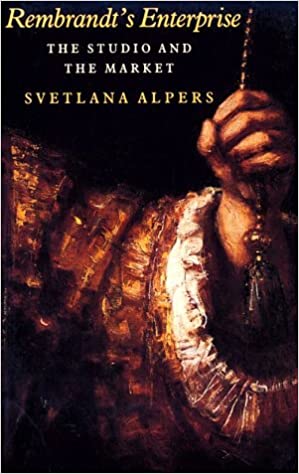
Rembrandt’s Enterprise: The Studio and The Market | Svetlana Alpers (1988)
A unique enterprise itself, this book is not without its critics. Alpers, an award-winning art historian and professor, contends that Rembrandt used his self-portraits to commodify his ‘brand’—and thus sell more of his art. Rembrandt was Warhol before Warhol. Contrary to what we might believe, self-promotion is not a new marketing tool.
By all counts, Rembrandt did more drawings and self-portraits than any artist before, or perhaps since. This miller’s son from Leiden quickly dominated the consumer market for paintings when he arrived in Amsterdam as a young man. He built a thriving studio that trained dozens of artists. Yet, how did this artist with fame and fortune under his belt, undeniable talent, and great energy, fall so rapidly from grace?
Rembrandt: His Life, His Paintings | Gary Schwartz (1986)
Sadly, this book is no longer in print; but, happily, the New York Society Library has a copy, and anyone interested in Rembrandt is the better for it. Gary Schwartz, an American art historian living in The Netherlands, is one of the foremost scholars on Rembrandt and the Dutch Golden Age. It’s worth noting that Simon Schama dedicated his Rembrandt’s Eyes (see below) to Schwartz. I loved this book. Even if you don’t read it thoroughly, it’s worth checking out for its lush images with their thoughtful descriptions, plus the entertaining sidebars scattered through the chapters. A true work of scholarship.
Rembrandt’s Eyes | Simon Schama (1999) 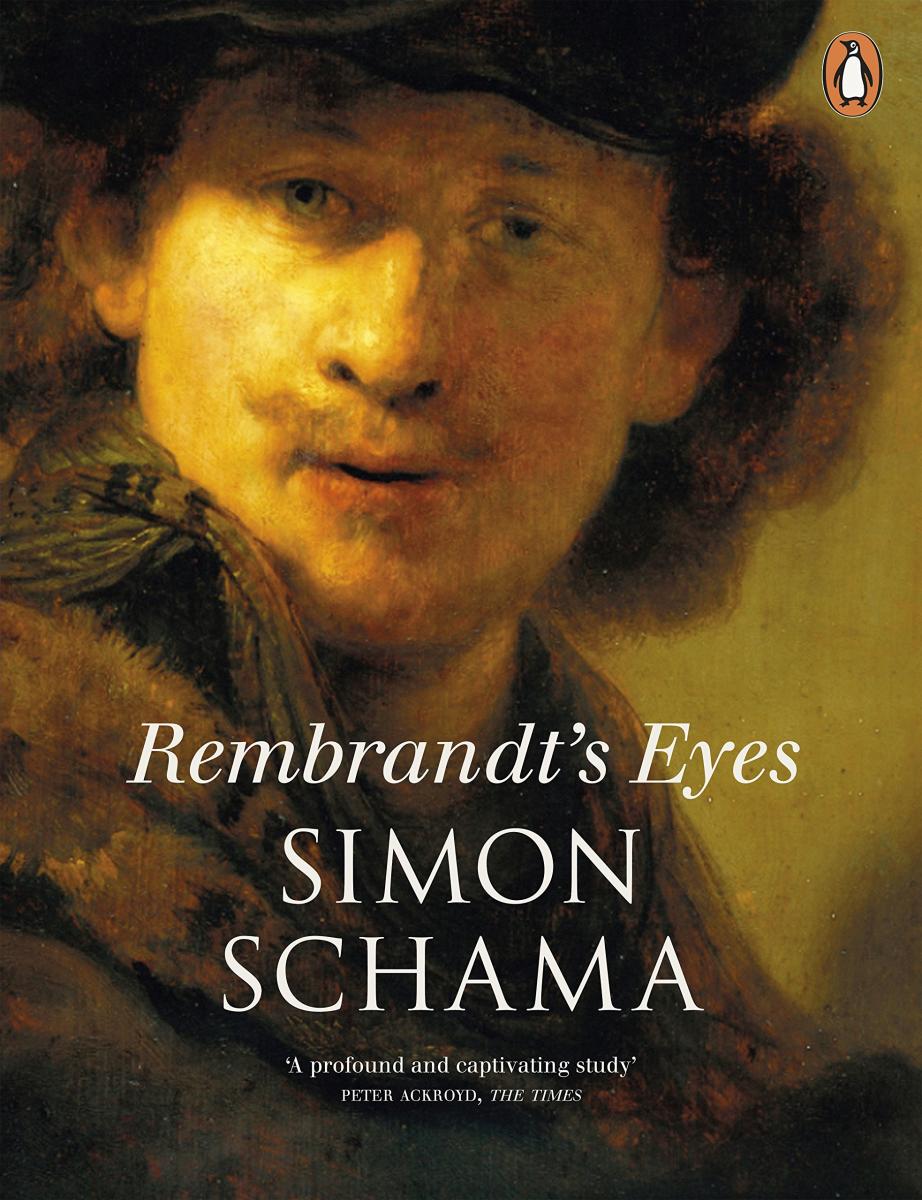
Simon Schama is an entertaining tour guide through Rembrandt’s life—and it turns out, Peter Paul Reubens’ life, too. This gargantuan tome (750 pages) is actually two biographies for the price of one. Speaking of self-promotion, it’s worth noting that Schama’s name is in larger type than Rembrandt’s on the paperback cover! It is typical Schama—littered with interesting stories and obscure facts, so it may take a bit of patience to manage.
It is Schama’s contention that Rembrandt was “utterly in thrall“ to Reubens, hence the author’s dive into Reubens. Though there are places in this narrative that left me asking, “How does Schama know? Where’s the evidence?” it is still an entertaining and theatrical romp through 16th- and 17th-century Dutch history. There are few authors writing today who can match Schama’s way with words.
In his November 18, 1999 Salon review, Matthew DeBord called Schama’s visual descriptions “scholarly porn” but adds that “fighting to keep up with Schama is worth the struggle. Rembrandt was among the most complex, compelling—and flabbergasting—artists who ever lived. He is well served by an equally daring biographer, one who isn’t afraid to take some chances in the service of his craft.”
EXHIBIT PAINTING 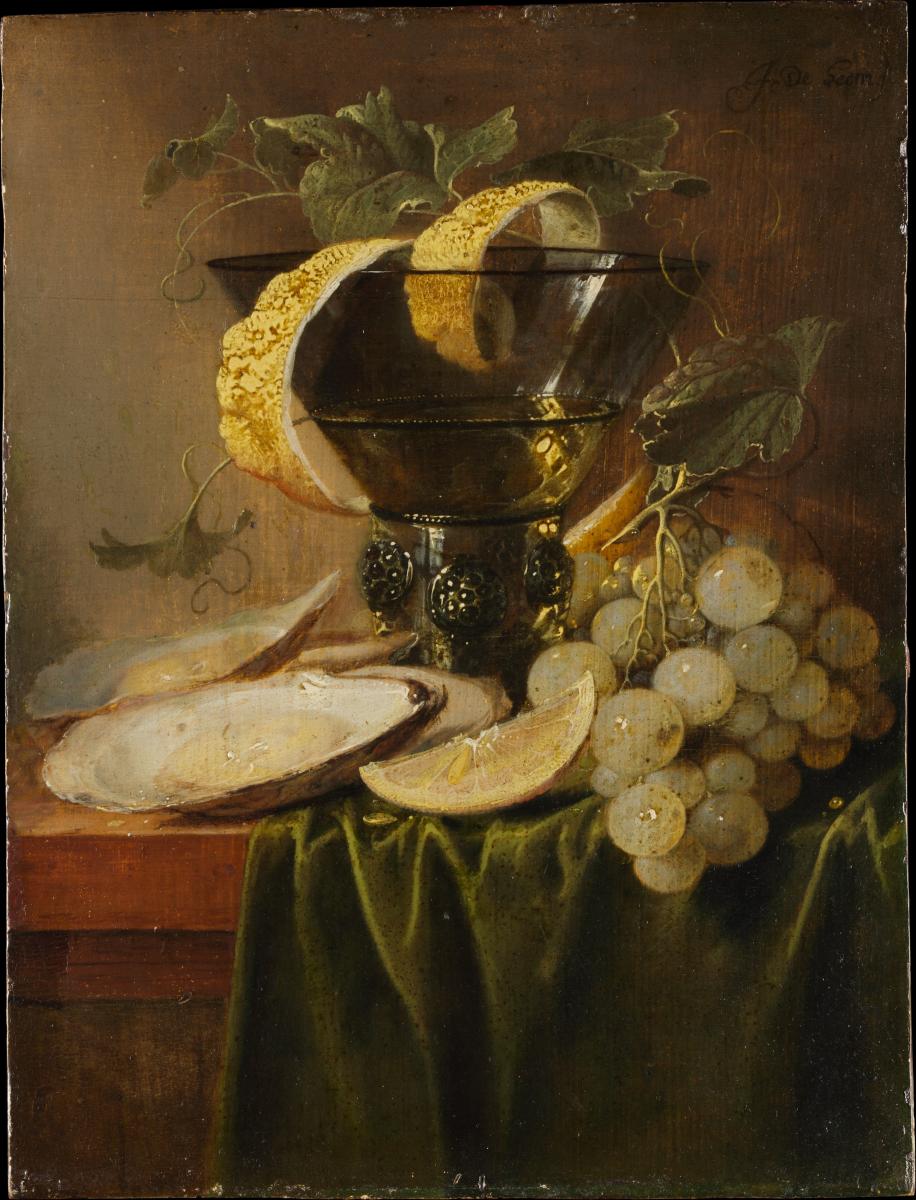
Still Life with a Glass and Oysters (ca. 1640) | Jan Davidsz de Heem
Still life painting was a staple of the Dutch Golden Age. These paintings are not just about familiar objects they are often loaded with hidden meaning—a story within a story. They could be used to signal sitter’s wealth, show his expanding knowledge of the world or be a cautionary tale about wealth, religion, or morality.
NYSL Book Recommendation
Still Life with Oysters and Lemon: On Objects and Intimacy | Mark Doty (2001)
Our lives are rarely still, and still life painting from the Dutch Golden Age does anything but still the life within, as the poet Mark Doty reminds us in his 2001 meditation.
Doty’s book begins with his visit to The Met (many years before the current exhibit) to see Jan Davidsz de Heem's Still Life with a Glass and Oysters. Given Doty’s poetic prose, it’s no surprise he was asked to provide commentary to accompany The Met exhibit. Both his audio that accompanies the show and his book are thoughtful orations on life and art.
EXHIBIT PAINTINGS
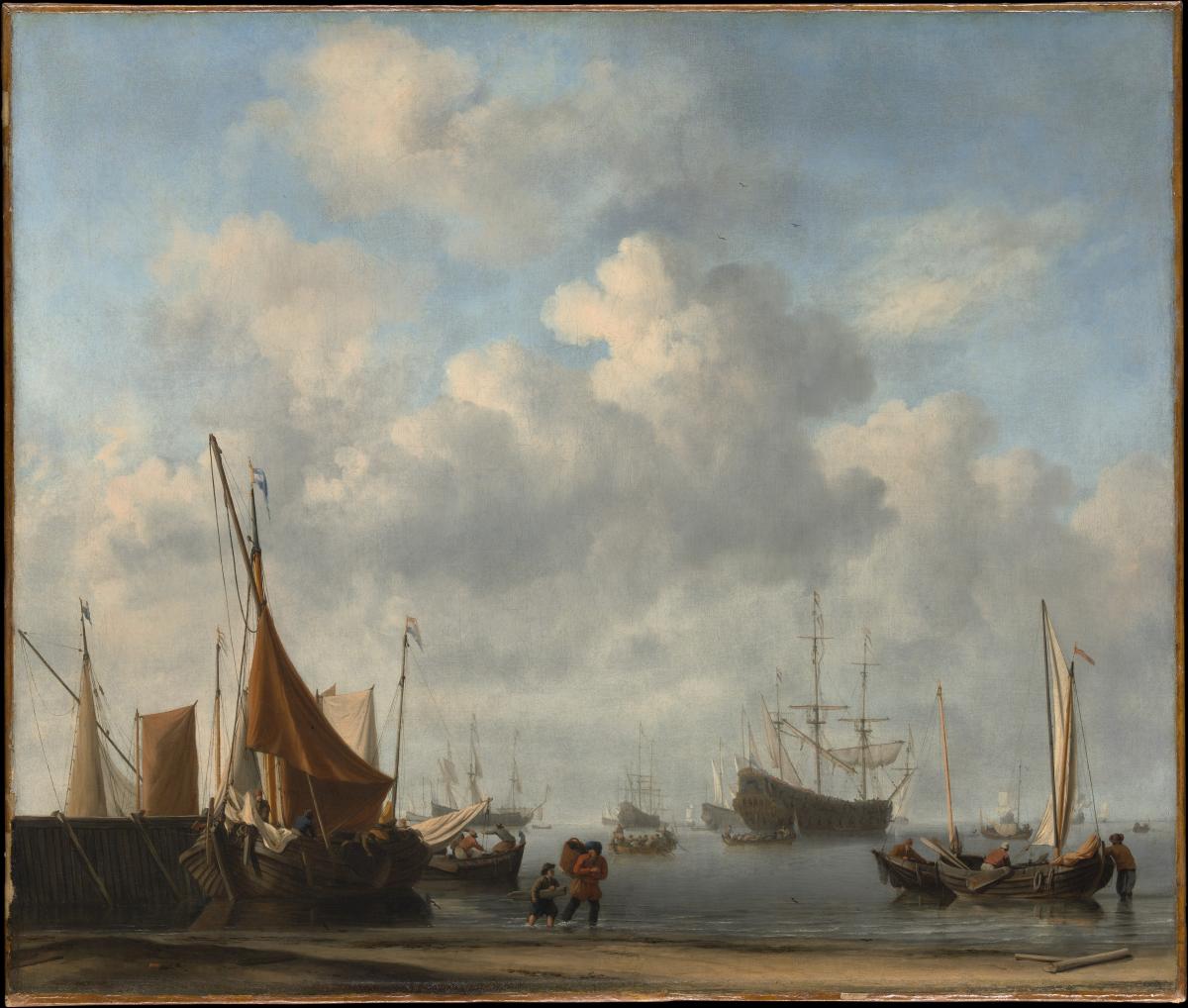
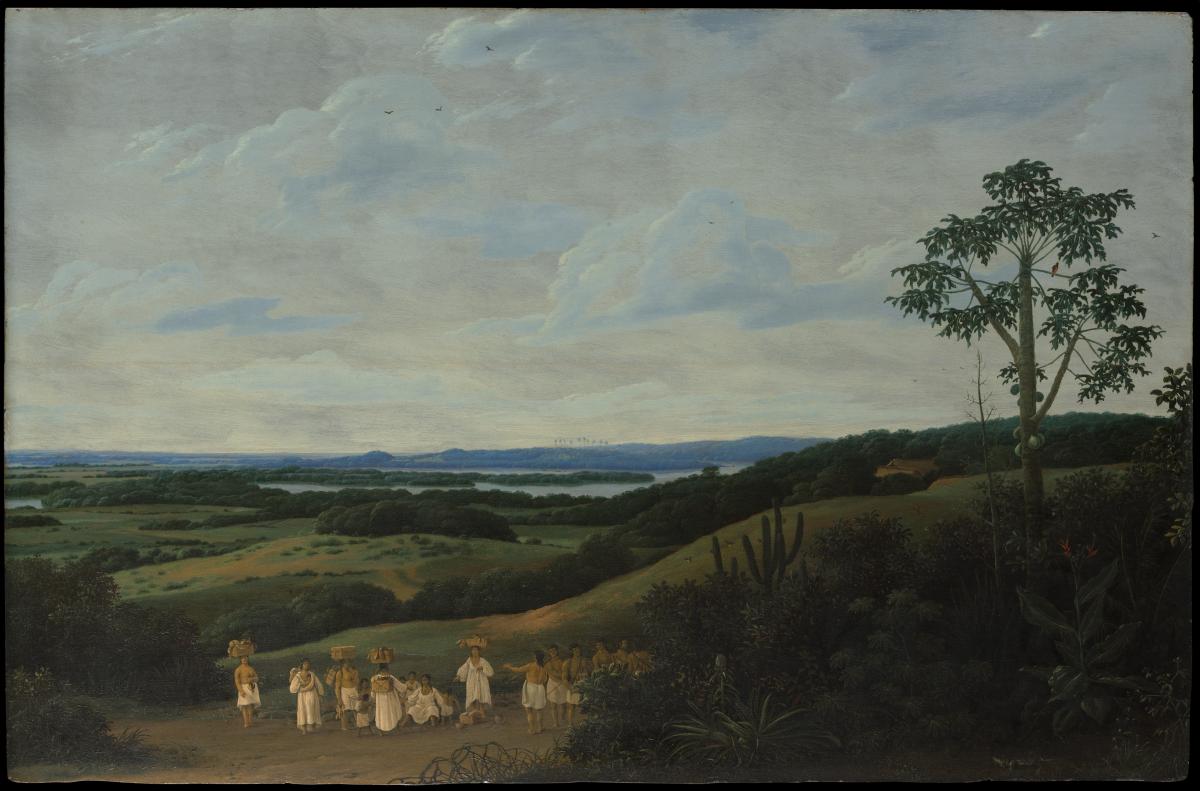
The Dutch Golden Age was an amazing era of global exploration at a time when ships were wooden, quarters were cramped, food was often inedible, and navigation frequently required guesswork. Dutch ports became the locus for exotic goods flooding the consumer marketplace.
There was a dark side to the Golden Age’s fascination with the exotic. The sordid history of the Dutch slave trade and the Dutch colonization of the Americas (Brazil, in particular) and Southeast Asia have often been ignored. Adam Eaker acknowledged the fraught history of collecting Dutch paintings in remarks he made at the opening of the exhibit:
“There are certainly blind spots with more of the darker chapters of Dutch history that aren’t represented in the paintings that we bought—and so I think this is also an opportunity for us to take stock and think about the Dutch paintings we might want to add to the Dutch collection in the next 150 years.”
NYSL Book Recommendations 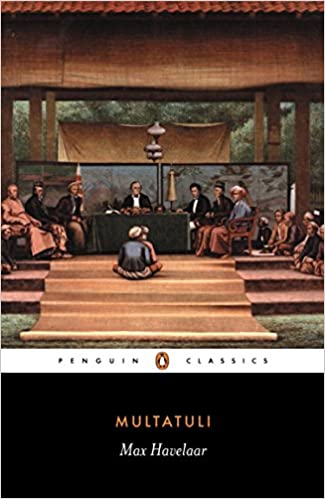
Max Havelaar: Or the Coffee Auctions of the Dutch Trading Company | Multatuli (1860)
A discussion of Dutch colonization can be found in the fictional Max Havelaar: Or the Coffee Auctions of the Dutch Trading Company, by Multatuli, a pen name used by Eduard Douwes Dekker meaning “I have endured much.” Published in 1860, Max Havelaar is a semi-autobiographical novel that was hailed as a Dutch masterpiece and credited with exposing the public at large to the sordid state of affairs in the Dutch colonies. The novel still generates controversy in Dutch circles and remains in print today.
The Coffee Trader | David Liss (2002)
If you’re looking for entertainment with some history, try The Coffee Trader by David Liss. This book was published several years ago to bestseller success. Liss sets his novel in 17th-century Amsterdam to tell the story of Miguel Lienzo, a Jewish refugee from the Portuguese Inquisition, desperate to remake his fortune. There are a sexy, mysterious woman, several bad guys, and of course, the new consumer commodity of coffee. Liss is known for his historical accuracy, and The Coffee Trader is no different.
Vermeer's Hat: The Seventeenth Century and the Dawn of the Global World | Timothy Brook (2008)
Contrary to its title, Vermeer's Hat is not about Vermeer—or his hat. A Canadian historian of China by trade, Brook’s wide-ranging history ingeniously uses six paintings and a porcelain dish as entry points for a broad cultural and historical discussion about trade routes, the global spread of smoking, the importance of silver, and the human cost of 17th-century global exploration. This is quite a good read, if occasionally too detailed. Brook’s central premise is that globalization—economic, political, and cultural—is not a 21st-century phenomenon , but was a product of the 17th century. Thought-provoking, even if you aren’t a history buff.
EXHIBIT PAINTINGS 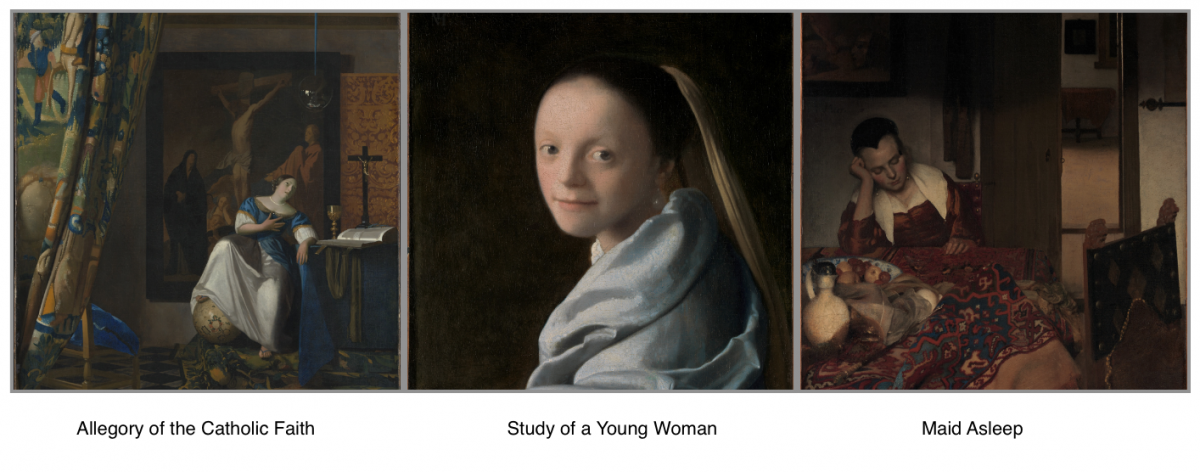
Allegory of the Catholic Faith (ca. 1670-72) | Johannes Vermeer
Study of a Young Woman (ca. 1665-67) | Johannes Vermeer
A Maid Asleep (ca. 1656-57) | Johannes Vermeer
If Rembrandt is the best-known name in this exhibit, Johannes Vermeer is a close second.
Considered provincial in his lifetime, he lived most, if not all, his life in Delft. Some speculate that he spent time in Amsterdam as a young apprentice, but there is no written record. Forgotten after his early death at 43, his star rose again in the 19th century when he became a favorite of collectors. Recently he gained wider attention with Tracy Chevalier’s blockbuster novel (and subsequent movie), Girl With a Pearl Earring.
Vermeer’s life and family are clouded in mystery. History knows few facts, so there is much hypothesizing. Was his maternal grandfather a counterfeiter of coins? How well did Vermeer know Antoni van Leeuwenhoek, “the father of microbiology?” Or was Leeuwenhoek merely the executor of his will? Did Vermeer, the master of perspective, use a camera obscura? How familiar was Vermeer with his contemporaries' groundbreaking work with lenses in telescopes, microscopes, and art?
NYSL Book Recommendation 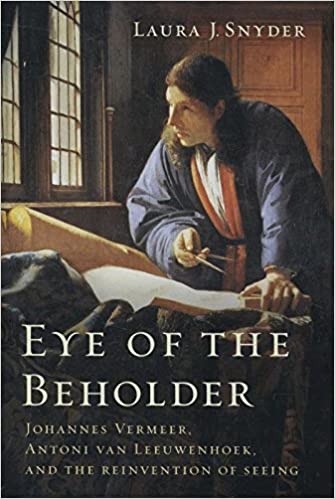
Eye of the Beholder: Johannes Vermeer, Antoni van Leeuwenhoek, and the Reinvention of Seeing | Laura J. Snyder (2015)
Snyder’s Eye of the Beholder ponders some of these questions as she paints a vivid picture of the art and science of Vermeer and Leeuwenhoek—two famous sons of Delft. One known for his painting, the other, a draper, remembered for his science.
Born the same year, living within blocks of each other and sharing acquaintances, there is no definitive evidence that the two conversed. But, Snyder builds her case. Surely, she leads the reader to believe, the two men knew each other and the work they were doing in their respective fields.
Snyder, a Mellon Fellow and Fulbright Scholar, writes entertaining narrative-driven non-fiction. Eye of the Beholder was named "A Best Art Book of the Year" by Christie's and "A Best Read of the Year" by New Scientist in 2015. Snyder is currently working on a biography of Oliver Sacks.
In 2011, Laura J. Snyder spoke about Eye of the Beholder at the Society Library. You can watch that lecture here.
ONE MORE WAY TO "READ" THE EXHIBITION: LOOTING, FORGERY, AND HEISTS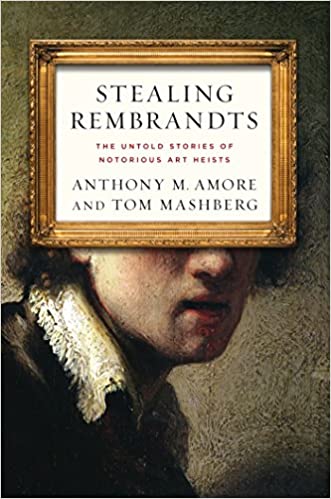
Though the following book recommendations are not directly related to The Met’s exhibit, they may provide some entertaining reading.
Paintings by the Dutch Masters have long been popular with forgers, thieves, and heads of state. The following recommendations tell some compelling stories that reveal the fascination—sometimes good, sometimes bad—with these masters.
Stealing Rembrandts: The Untold Stories of Notorious Art Heists | Anthony M. Amore and Tom Mashberg (2011)
This book is written with insiders’ knowledge, and it is an entertaining and beguiling read. Anthony Amore is Director of Security and Chief Investigator at the Isabella Stewart Gardner Museum. He is charged with ongoing efforts to recover thirteen artworks stolen in 1990 in one of the greatest art thefts in history. The co-author, Tom Mashburg, is an award-winning investigative reporter and the former Sunday editor for the Boston Herald. Anthony Amore also recently published The Woman Who Stole Vermeer: The True Story of Rose Dugdale and the Russborough House Art Heist (2020). Dugdale was the child of a wealthy English family, a former debutante with an Oxford PhD, and Library Journals praises Amore's chronicle of her career of prolific art thievery as a "seamless blend of true crime, biography, and art history."
The Forger's Spell: A True Story of Vermeer, Nazis, and the Greatest Art Hoax of the Twentieth Century | Edward Dolnick (2008)
I’m a fan of Edward Dolnick. I first ran into his work several years ago at The Met Museum’s bookstore. In this book, Dolnick tells the story of a marginal Dutch artist, Han van Meegeren. Unable to make a living as an original artist, he turned himself into a forger of Vermeers. He was so good, experts and collectors were fooled, including the second most powerful Nazi, Hermann Goering. Van Meegeren walked away with about $30 million before his forgeries were exposed. Given what we know today about the Nazi looting of art treasures, there seems to be some poetic justice in the improbable story that Dolnick recounts.
The Rape of Europa | Lynn H. Nicholas (1994) 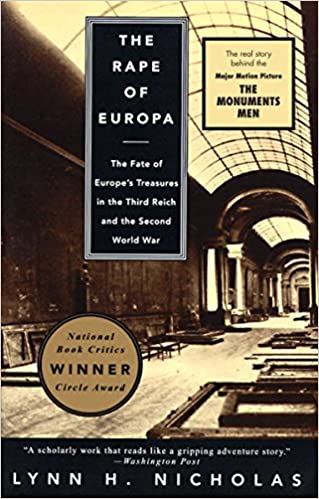
This National Book Critic’s Circle award winning book tells a very different tale about the life of paintings. Nicholas meticulously follows the fate of many public and private art treasures during and after World War II. The Dutch Masters were a choice looting target of the Nazis. Adolf Hitler’s favorite painting was said to be Vermeer’s The Astronomer. This detailed chronicle was made into a fine documentary film in 2006.
Painting images courtesy of The Metropolitan Museum of Art.
Heidi K. Weber writes about books on her email newsletter, TheLiterarySalon.com. She also leads webinars and workshops that bring books alive in your personal and professional life.
